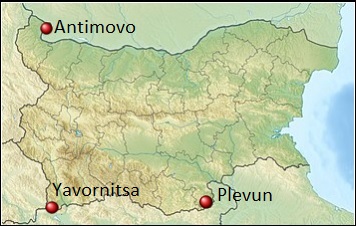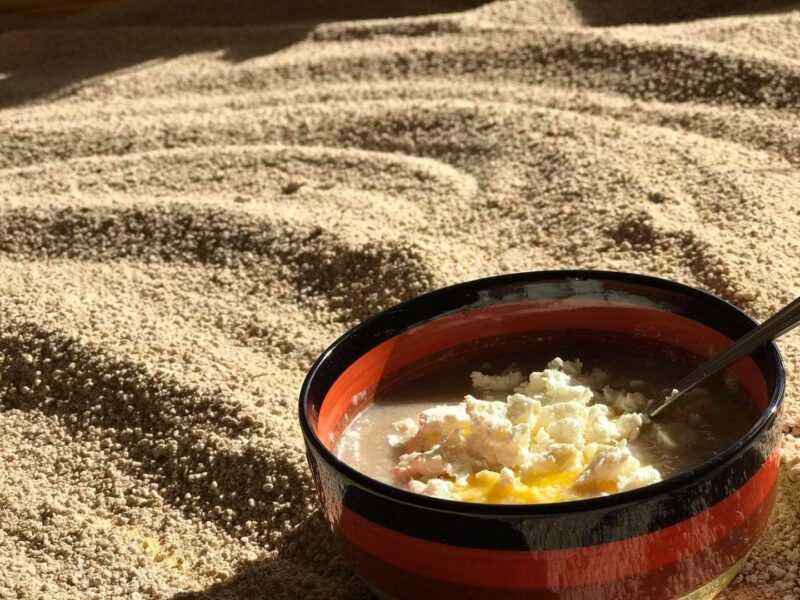This is the second of a three-part series by Dessislava Dimitrova and Nevena Borisova about how women entrepreneurs drive the revival of culinary traditions in different parts of Bulgaria, as part of the modern Slow Food movement, boosting tourism and countering depopulation.
Tarhana is a food originating from Persia, and it is prepared and consumed in southeastern Europe and the Middle East. In general, it is a type of pasta, which is prepared with sourdough, based on a dried fermented mixture of flour and yoghurt (white tarhana) or fruits and vegetables (red tarhana). This artisanal food is poorly known today, while only a few decades ago it was regularly prepared in many homes in the Bulgarian mountains of Strandzha, Sakar, and Rhodopes.

Map of Bulgaria showing the locations of villages Yavornitsa, Antimovo and Plevun. Based on maps from respective Wikipedia articles, CC BY-SA 3.0.
Different dishes with tarhana also have been made on a daily basis in the southern village of Plevun where, as a child, Temenuzhka Mateva had been often with her grandma. Years later, due to sentimental reasons, Temenuzhka decided to revive the tradition and have turned into its keeper. She said:
„Траханата бе закуска сутрин през цялата зима, но баба я добавяше и към всяко вече готово ястие – като поизстине, все поръсваше. Сега разбирам, че го е правила, за да „подсили“ храната, запазвайки и пробиотичните свойства на траханата. Например, на кисело мляко ще сложи малко, ще си надробим и ще ядем. На готов фасул, вече изстинал, и там поръсваше!“
“The tarhana was our breakfast during the whole winter, and grandma also added it to every dish which was already prepared. When the dish got colder, she was always sprinkling some tarhana. Now, I understand that she made that in order to “strengthen” the food because this is also a way to preserve its probiotic qualities. People in the past knew so much!”

Temenuzhka Mateva (on the right) with her granddaughter. Photo from personal archive, used with permission.
She adds that the recipe reflects local specifics of the region itself. For example, some villages for example, where different kinds of vegetables are grown, a variety of vegetables were mixed with dough for the tarhana. And, in case that the local livelihood is related to sheep breeding, the dish is prepared with more yoghurt in it.
Temenuzhka prepares a specific kind of tarhana, without adding yoghurt to it, nor fruits or vegetables. In order to make sourdough, she puts hops, corn, chickpea and lentils in water, and, after the water boils, and the ingredients float up on the surface, she sieves the mixture, and adds einkorn wheat and rye flour. The sourdough starter is left to rise, and is then mixed with the remaining flour and bulgur.
The other part of the tarhana is the cereal bulgur, processed from einkorn wheat. After the dough is made (from the bulgur, sourdough and the einkorn wheat), it should be left to rise 2-3 days, in a warm environment. At the end, the risen dough is sifted through a perforated sieve, so called darmon (дармонь in Bulgarian). The resulting grains have to be dried in the sun, after which they are stored in paper or textile bags for the whole winter. As for the cereal ingredients, Temenuzhka personally prefers einkorn and rye, because they are plant cultures that can be grown without chemicals.
The tarhana is a way to conserve the healthy nutritional qualities of yoghurt, fruits and vegetables and the sourdough via fermentation. This food, usually prepared in summer after harvest, comes in two specific varieties: white and red. Since its preparation does not include a thermal process, it can be safely called “live food,” rich in lactic-acid bacteria.
While the tarhana has been a protection against famine in the past, it now serves as a shield against the loss of a cultural memory.
Започнах да приготвям трахана, откакто имам внуче. Замислих се, че сега, когато съм баба, е време да предам на децата си онова, което съм запомнила от моята. В продължение на години опитвах да я възстановя такава, каквато я помня.
I started preparing the tarhana since I've become a grandmother, having the idea that it is now time to transfer the knowledge of what I have learned from my grandmother to the next generation. And, in a couple of years, I succeeded in recreating this food exactly like I remember it.
Temenuzhka tries to popularize the product, but still faces a variety of difficulties because of food safety regulations. Tarhana has not been formally registered as a dish, and therefore it is more difficult to offer it in restaurants. Despite this she has created a Slow Food community in the region of Ivaylovgrad, and also uses social media group to make the food more popular.
Recently, many people who have tried the tarhana are willing to learn how to prepare it. For those people who appreciate the long-century tradition, Temenuzhka considers organizing workshops in Plevun, hoping that her efforts will bring the food back on the Bulgarian table.
This article is part of a series on reviving Bulgarian culinary traditions as a way to restore cultural memory, highlighting the experience of women entrepreneurs working in depopulated rural areas. The series comprises the following articles:
– Wild herbs of village of Yavornitsa
– Grandma's unforgettable tarhana from Plevun
– Granny's forgotten dishes in the village of Antimovo







